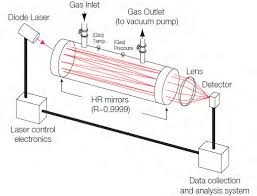Instrument Support Level 2
Los Gatos Research Ultraportable Greenhouse Gas Analyzer
ncas-ugga-1
ch4-co2-h2o-concentration
£40, 000
18 cm x 47 cm × 35.5 cm, 17kg
44 cm x 23 cm x 79 cm, 20kg.
£20
Calendar
Los Gatos Research Ultraportable Greenhouse Gas Analyzer
The Ultraportable Greenhouse Gas Analyzer (UGGA) reports measurements of methane, carbon dioxide and water vapour simultaneously in a package that is compact and crushproof. Small enough to be carried on-board aircraft (TSA approved size) and requiring only 70 watts, within 100 seconds after power-up, and may be operated wirelessly with an iPhone or Tablet.
The UGGA reports and stores all measured fully resolved absorption spectra which allows the instrument to accurately correct for water vapour dilution and absorption line broadening effects and thus to report CH4 and CO2 on a dry (and wet) mole fraction basis directly without drying or post-processing.
The UGGA uses laser absorption spectroscopy to detect and quantify CO2, CH4 and H2O in a gaseous matrix, by measuring their associated optical absorption when irradiated with a light beam, as per Beer-Lambert law. The UGGA Analyzer uses LGR’s patented Off-axis ICOS technology, a fourth-generation cavity enhanced laser absorption technique.
The instrument is linear across the measurement ranges:
- CH4 : 0.01 – 100 ppm
- CO2 : 1 – 20000 ppm
- H2O: 500 – 70000 ppm
It has a 10 second response time and reports dry mole fraction.
Integrated cavity output spectroscopy (ICOS) sometimes called as cavity-enhanced absorption spectroscopy (CEAS) records the integrated intensity behind one of the cavity mirrors, while the laser is repeatedly swept across one or several cavity modes. However, for high finesse cavities the ratio of “on” and “off” a cavity mode is small, given by the inverse of the finesse, whereby the transmission, as well as the integrated absorption, becomes small. Off-axis ICOS (OA-ICOS) improves on this by coupling the laser light into the cavity from an angle with respect to the main axis so as to not interact with a high density of transverse modes. Although intensity fluctuations are lower than direct on-axis ICOS, the technique is, however, still limited by a low transmission and intensity fluctuations due to partly excitation of high order transverse modes, and can again typically reach sensitivities ~10−7 .

There is no front panel display but the CH4, CO2, H2O concentrations are available over the serial or ethernet connection.
The calibration of CO2 and CH4 is achieved through the use of a gas calibration standard containing known concentrations of these gases. The water measurement can be checked through the use of a dewpoint generator.
The instrument is calibrated prior to deployment.
Consumables
- No consumables are needed for this instrument.
- For longer deployments or for aircraft work a calibration cylinder containing known levels of CH4, CO2 is recommended.
Costs
- Instrument Insurance
- This system must be insured by the user for £40K and covers loss, theft or damage to the instrument: damage is that over and above general wear and tear. The system has been designed to be rugged and autonomous. Even so, the end-user must respect the fact that the system is a precision optical instrument that must be treated with great care.
- The user is responsible for the instrument from the time it leaves the AMOF to the time it is returned and signed off as in an acceptable operating condition by the IS: this will be done as soon as is possible on its return.
- Public Liability Insurance
- The AMOF is not liable for any damage or injury arising from the deployment or operation of this instrument when unattended by the IS.
- Shipping Expenses
- The user is liable for all costs arising from the shipping of the instrument both to and from a deployment.
- IS T&S
- The user is responsible for coving the travel and subsistence expenses of the IS while attending the instrument.
Shipping
- The system when packed ready for shipping consists of a single box,
- Shipping dimensions:
- 44 x 23 x 79 cm,
- Shipping weight
- 20kg
Installation of instrument
- The instrument requires the use of the supplied external AC/DC power supply.
- The analyser should be operated from an air-conditioned laboratory
Inlet
- A ¼” sampling line should be located outside the laboratory and secured to the common sampling point, ensuring that no liquid water can enter the line.
General
- The instrument is self-enclosed so many of the potential hazards from the instrument are reduced. Do not remove any panels unless approved by instrument scientist.
Electric safety
- All instruments must be powered down before any maintenance can be performed. For major instrumentation powered through UPS, make sure there is no overload of the system.
- All electrical devices must be checked by an electronics workshop and certified.
- Operators must have knowledge of the location of exposed electrical connections.
- Ensure instruments are earthed at all times.
When unpacked both instruments have the following physical specifications:
Footprint
- 18 cm (H) x 47 cm (W) × 35.5 cm (D)
Weight
- 17 kg
Power
- 60 watts (10-30 VDC)
- 66 watts (115/230 VAC, 50/60 Hz)
The instrument is linear across the measurement ranges:
- CH4 : 0.01 – 100 ppm
- CO2 : 1 – 20000 ppm
- H2O: 500 – 70000 ppm
and is reported as the dry mole fraction.
Field Data
- Data is available to download from the logging laptop as txt files.
- The user can download (but not delete) this data from the instrument but it should be noted that this data will not have been quality controlled.
Archive data
- Data is provided in NetCDF files following the AMOF data standard
- Files contain no more than 24 hours worth of data.
- Instrument name is
- ncas-ugga-1
- The data product(s) associated with this instrument:
- Example data file
